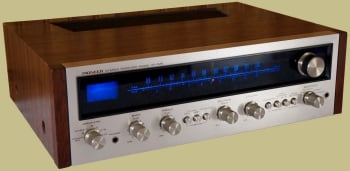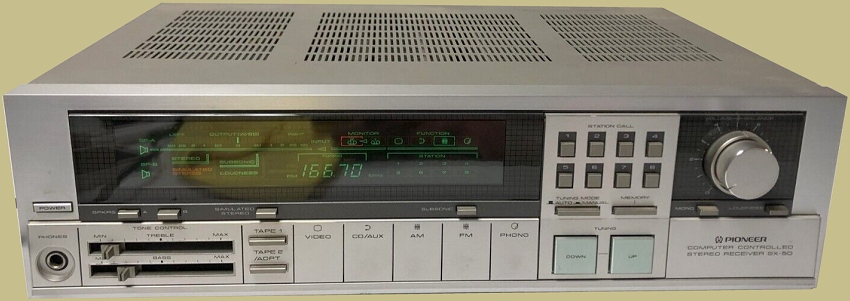
The Pioneer SX-50 was introduced in 1983 and had a retail price of $380. It is a computer controlled stereo receiver and embraced emerging audio technologies, supporting TV audio inputs and also anticipating the rise of the compact disc. It pioneered multiple audio inputs and allowed switching between emerging formats like CD players and hi-fi videodisc soundtracks. Its forward-thinking design made high quality audio integration intuitive and uncomplicated.

The SX-50 produces 50 watts per channel and has a very low rating of .007% total harmonic distortion. The sound is characterized as clean as opposed to warm and the tuner is adequate in areas of strong signals. It was part of Pioneer’s lineup that included the SX-40, SX-60, and the top of the line SX-V90 which came out a bit later. Here are the prices and power outputs of the models:
- SX-40 38 wpc .02 thd $300
- SX-50 50 wpc .007 thd $380
- SX-60 80 wpc .005 thd $500
- SX-V90 125 wpc .005 thd $800
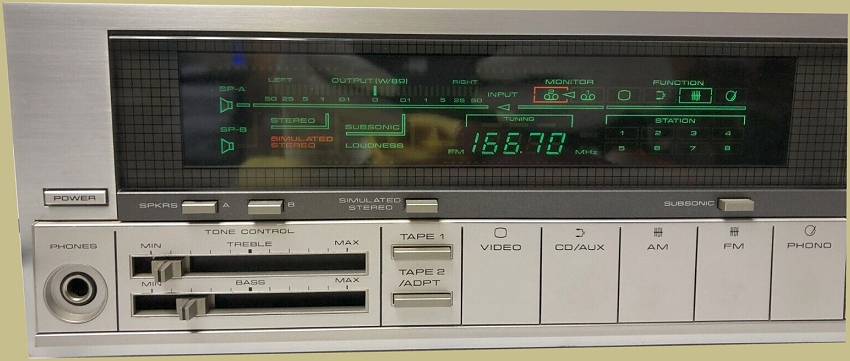
Front Panel
If you’re into the retro 1980’s look then the Pioneer SX-50 probably looks cool to you. The numerous push buttons with different coloration and of course the large green vacuum fluorescent display give it a new wave look. Pioneer used sliders for the tone controls and large push buttons for the input selections. The simulated stereo button was mainly for TV sound which was usually mono but could be hooked up through the SX-50 which would separate the input signal and create a simulated stereo output. More on that below.
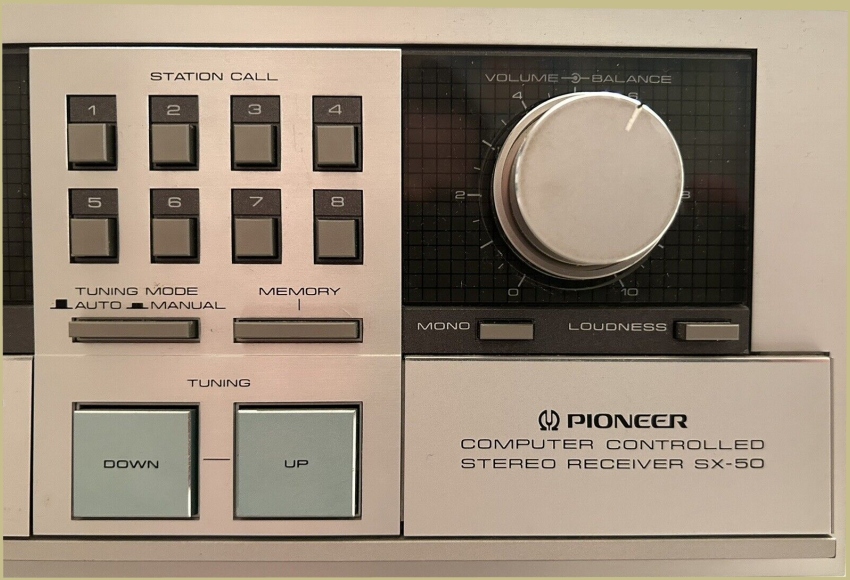
Tuning
The display and controls on the Pioneer SX-50 are designed to make operation intuitive and provide feedback on the receiver’s status. Here are the main features of the tuner:
- The Pioneer receiver has manual tuning where you tune to stations manually, as well as automatic tuning that seeks out stations on its own in both directions.
- It can store 8 preset stations for both AM and FM bands. When you reach one end of the band, it jumps to the opposite end and keeps tuning in the same direction.
- The LED display visually shows which direction the auto-tuning is scanning, lighting up sequentially. The center light indicates when a strong station is found.
- The display panel shows the status of all the settings, like volume, balance, bass, treble, tuning mode, etc. It gives you visual feedback on what the receiver is doing.
- When you turn the receiver off and back on, it remembers the last tuned station and settings and returns to them automatically.
- You can also return to the last tuned station by pressing the preset buttons, which will change the station but keep the AM/FM band the same.
- The bass and treble (tone) controls use sliding levers with a center detent position for flat/neutral.

The tuner performance in the Pioneer SX-50 receiver is typical for its price range at the time. It should work fine for most people, unless you live in an area with weak radio signals. The issue is that it requires a very strong signal to receive stereo FM stations – 36.25 dB or higher. Most other receivers can get stereo FM with signals well below 30 dB.
So in rural areas far from broadcast towers, the Pioneer may not be able to receive stereo FM stations that other receivers could get in stereo. It waits for a very strong signal before switching to stereo mode. People in urban and suburban areas with strong radio signals probably won’t have any issues.
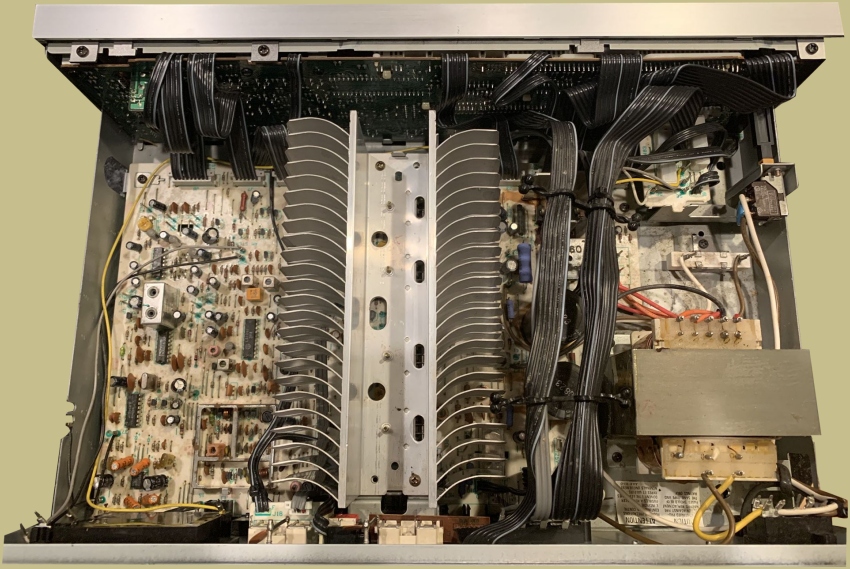
TV Sound
The Pioneer SX-50 receiver can take a mono audio signal and make it sound like stereo, even if the original source is not stereo. It does this through a process called “stereo simulation.”
Most stereo simulation works by splitting the audio into different frequency bands and sending some bands to the left speaker and some to the right. This makes a mono signal sound wider when you hear it from both speakers.
But the Pioneer SX-50 used a different approach – it shifted the phase of the audio signal, so the left and right channels are out of sync by different amounts at different frequencies. The phase shift starts small in the bass and gets bigger at higher frequencies. This makes the sound seem to come from beyond the speakers if you’re far away, but up close it sounds a little muddy. The SX-50 can apply this effect to any audio source, not just TV sound. It was an unusual feature for its time.
Rear Panel
The SX-50 has inputs for a phono, two tape decks, an aux and video. The auxiliary input of the Pioneer SX-50 receiver was specifically intended for connecting a CD player. There was also a separate input for TV audio that could handle true stereo signals, feed mono sound to both channels, or simulate stereo from a mono source.

The TV audio input has an unusual configuration – if only the left channel jack is used, the signal will feed both left and right speakers. But if a cable is also plugged into the right channel jack, the channels will function independently. There are also jumpers that allow the user to separate the tuner/preamplifier and power amplifier sections, enabling insertion of an equalizer or other device between them.
The SX-50 can handle two sets of speakers. Terminal strips with clamp connectors serve both speaker outputs and antenna inputs, accepting bare wire connections for FM twin-lead and the included AM loop antenna with ground. The receiver has a battery compartment holding three AA batteries to retain tuned station memory without power. There are also two AC outlets.
Specifications
- Power output: 50 watts per channel into 8Ω (stereo)
- Frequency response: 5Hz to 100kHz
- Total harmonic distortion: 0.007%
- Input sensitivity: 2.5mV (MM), 150mV (line)
- Signal to noise ratio: 80dB (MM), 95dB (line)
- Output: 150mV (line)
- Dimensions: 420 x 120 x 311mm
- Weight: 7.2kg
- Year: 1983
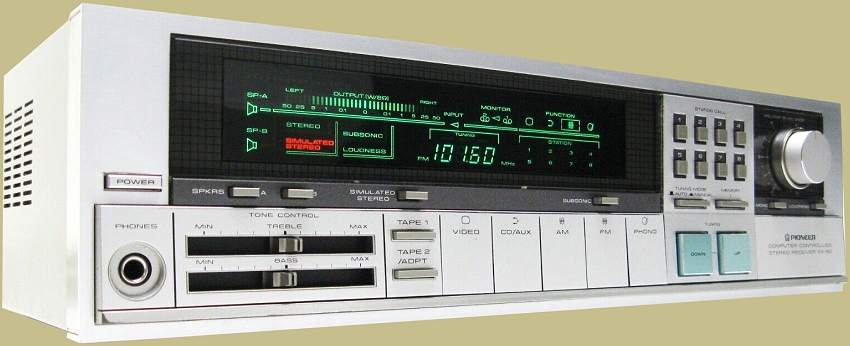
Reviews
Great little receiver. Super clean sound. Excellent specs.
Has pre out/main in RCA jacks so connecting a subwoofer using preamp inputs is super easy.
Just the aesthetic alone is so cool.
The Pioneer SX-50 is a good receiver and is collectible as it represents the transition from the silver faced analog era into the digital era as well as from standalone stereo receivers to audio/video receivers. We all know how that went as surround sound features later dominated the market.

